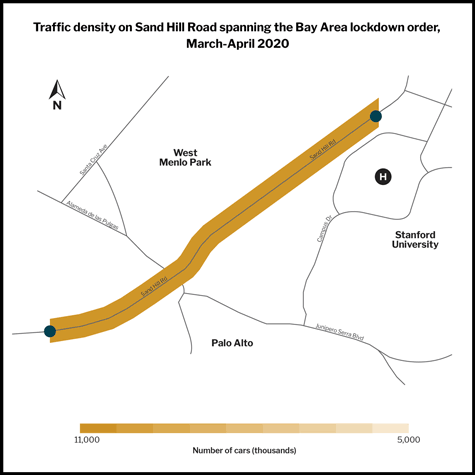Source: Geophysical Research Letters
Sand Hill Road is the major artery carrying venture capital money to tech start-up hopefuls in the beating heart of Silicon Valley. On a typical spring day, its lanes are packed with tech commuters and would-be CEOs vying for the attention of would-be angel investors in firms flanking its length. But on 16 March, the California COVID-19 stay-at-home order shuttered offices along Sand Hill Road and cut the street’s usual bustle in half, according to a new study.

A team of researchers with the Stanford University Geophysics Department captured the sudden drop-off in traffic in real time by borrowing a telecommunications cable buried under the road to sense the vibrations of passing vehicles.
Lindsey et al. found traffic on the main road dropped 50% immediately following the stay-at-home order, whereas traffic near Stanford University Medical Center dropped off more gradually and leveled off at about 80% of prequarantine levels.
The results matched location tracking data released by mobile phone companies like Apple and Google. Unlike mobile phone data, however, the method used by the researchers is anonymous and accounts for individual cars that passed over the road.
A New Way to Record Rumblings in Earth
To achieve their results, researchers used an emerging technology called distributed acoustic sensing (DAS) that can take advantage of the world’s network of fiber-optic cables to record seismic waves. Fiber-optic cables are what make things like cable TV, long-distance phone calls, and the Internet possible. They’re under our cities but also stretch across more remote places like the ocean. Hit “send” on an email, and a light pulse encoded with data passes through a strand of glass fiber and zips your message to its destination.
With DAS, researchers have discovered yet another use for these laser pulses—one with far-reaching implications not only for scientific studies of geological processes but also for the development of smart cities. As a light pulse passes down the length of the cable, it bounces around differently on the basis of the amount of strain placed on the wire it’s traveling through.
“As the pulse propagates out, it scatters in a way that allows us to actually analyze the strain that’s applied to small sections of the fiber,” said Nate Lindsey, a geophysicist at Stanford University and lead author of the new study.
By analyzing how the light scatters down the cable’s length, scientists can precisely pinpoint how the ground is vibrating or straining and even link that motion to its source. In the case of a city, the sound of a voice or the rumble of a car’s engine emits short-wavelength seismic waves that move out across the city. The force of a car pressing down on the ground produces a longer and more localized wavelength by straining the area under the car. The DAS method can pick up a wide range of frequencies with great precision down the length of the cable, collecting data that would take hundreds or even thousands of individual seismic sensors using conventional methods.
Putting DAS to the Test
Putting the capabilities of DAS to the test on Sand Hill Road during quarantine was, in part, a matter of luck. “Our group had been recording on this cable continuously for months when the coronavirus crisis hit,” Lindsey said. “We were able to just pull the data on the fly and begin analyzing it.”
Researchers found that although they were picking up high-frequency city sounds like car engines, which is the sort of data a classical geophone would pick up, their data also showed the footprint of individual vehicles. When a car moves along a road, the road compresses ever so slightly under the weight of the tires. Distributed acoustic sensing was picking up the low-frequency vibrations produced by this compression.
“We were able to see the high-frequency vibrations like what geophones would see, as well as this deformation of the roadbed with the exact same instrument,” Lindsey said. “That’s a really useful result because it allows us to count individual vehicles.”
When Lindsey and his team counted up the number of cars on the road recorded using the telecommunications cable, they found that traffic on Sand Hill Road dropped significantly after the 16 March shelter-in-place order, falling from about 11,000 vehicles per day to 5,000 per day—a 40% to 60% decrease. Near the Stanford hospital, meanwhile, the number of vehicles remained steady at about 2,000 per day. After 2 weeks, the traffic near the hospital dropped off to about 80% of prequarantine levels, potentially because the Stanford clinics closed at that time.
In the future, Lindsey said, DAS could be used as a more direct and anonymous tool for collecting data on human activity levels by government and public health officials during times of crisis.
“These existing sensor networks could be tapped into to reform the way traffic is currently monitored,” he said. (Geophysical Research Letters, https://doi.org/10.1029/2020GL089931, 2020)
—Rachel Fritts (@rachel_fritts), Science Writer
Citation:
Fritts, R. (2020), Fibers pick up Silicon Valley traffic changes during quarantine, Eos, 101, https://doi.org/10.1029/2020EO150012. Published on 01 October 2020.
Text © 2020. The authors. CC BY-NC-ND 3.0
Except where otherwise noted, images are subject to copyright. Any reuse without express permission from the copyright owner is prohibited.

